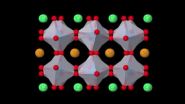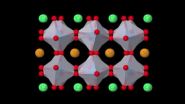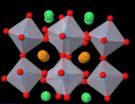(Press-News.org) VIDEO:
Researchers in Drexel's College of Engineering have discovered a way to classify and predict the existence of a rare breed of electrically conductive polar metals.
Click here for more information.
PHILADELPHIA - Drexel University researchers are turning some of the basic tenets of chemistry and physics upside down to cut a trail toward the discovery of a new set of materials. They're called "polar metals" and, according to many of the scientific principles that govern the behavior of atoms, they probably shouldn't exist.
James Rondinelli, PhD, a professor in the College of Engineering, and Danilo Puggioni, PhD, a postdoctoral researcher in the College, have shed light on this rare breed of electrically conductive polar metal—whose atomic makeup actually has more in common with a drop of water than a flake of rust—using an advanced computing method called density functional theory.
This automated system of virtual chemical match-making sifts through volumes of structural chemistry data to churn out combinations of elements that could exist as stable compounds. Rondinelli and Puggioni, both members of Drexel's Material's Theory and Design Group, worked through a step-by-step process to isolate shared features of known polar metals, thus creating a way to classify them.
"We sought first to classify all known compounds and look for commonalities and ways to systematically describe them," Rondinelli said. "By creating the classification scheme we identified the key features. That knowledge was formulated into a working principle that allowed us to predict a new compound using quantum mechanical calculations."
These metals are considered rare because of their unusual atomic and chemical structure, specifically, an imbalanced distribution of electrons in a material with metal cations and oxygen. Most metallic materials have an even or symmetric distribution of electrons, in other words it does not have positively and negatively charged poles. But these asymmetric polar metals, appear to be an exception to the rule.
"They challenge our notions of what it means for a material to be a metal or to be polar," Rondinelli said. "By polar, I mean just like the water molecule, which has an asymmetric distribution of charge. It's nearly the same case here, where the material we predict is polar, but it is simultaneously metallic owing to mobile electrons, rather than bound electrons."
Scientists have hypothesized the existence of polar metals, dubbed "metallic ferroeletrics" by Nobel Laureate Phil Anderson, since the 1960s -but with little theoretical understanding of how to discover them. Since then, researchers have essentially stumbled upon about 30 metals with asymmetric charge distributions.
More than half a century later, Rondinelli and Puggioni were able to examine the crystal structure of these known polar metals, and show that the geometric arrangement of atoms is key to understanding their asymmetric charge distribution. This information, in turn, will make it possible for materials scientists to discover more compounds.
Putting their theory to the test, the duo designed a polar metal of their own. The material, chemically termed strontium-calcium ruthenate, (Sr,Ca)Ru¬O6, is currently in the theoretical stage, but Rondinelli and Puggioni are working with experimental groups around the country to produce the compound in a laboratory.
While it's too early to predict what applications these materials are ideally suited for, other materials in this class of polar metals are superconducting—they are able to conduct electricity with zero resistance—so they could find use in a variety of advanced electronic and thermal devices. The pair's research was funded by the Army Research Office's Young Investigator Program and was recently published in Nature Communications.
"The way these materials behave and the reasons for their stability are rather unconventional, yet our classification scheme provides a general design strategy that could guide the discovery and realization of many more polar metals," said Rondinelli. "I don't believe these materials are as rare as is currently thought despite their counterintuitive nature; researchers may have simply been looking in the wrong places."
INFORMATION: END
Drexel researchers open path to finding rare, polarized metals
2014-04-02
ELSE PRESS RELEASES FROM THIS DATE:
A rainy day can ruin an online restaurant review
2014-04-02
After looking at 1.1 million online reviews for 840,000 restaurants in more than 32,000 cities across the country, Georgia Tech and Yahoo Labs researchers have found that the weather outside can be just as significant a factor for reviews as what happens inside a restaurant. Their study shows evaluations written on rainy or snowy days, or very cold or hot days, are more negative than those written on nice days.
"People love to describe themselves as foodies. But in the end, it looks like we're all weather people, whether we realize it or not," said Saeideh Bakhshi, a ...
Pharmocogenomics has not fulfilled its promise to developing countries
2014-04-02
From 1997 to 2010, despite promises made by the international scientific community, pharmacogenomic research produced few studies focusing on rare, orphan and tropical diseases prevalent in developing countries. Catherine Olivier, bioethics research at the University of Montreal's School of Public Health, recently published these findings in the journal Global Public Health.
Pharmcogenomics is a field of scientific research that studies the interaction between the genomic information of individuals (or populations) and their responses to drugs. In addition to its promising ...
The science of champagne fizz: How many bubbles are in your bubbly?
2014-04-02
The importance of fizz, more technically known as effervescence, in sparkling wines and champagnes is not to be underestimated — it contributes to the complete sensory experience of a glass, or flute, of fine bubbly. A scientist has now closely examined the factors that affect these bubbles, and he has come up with an estimate of just how many are in each glass. The report appears in ACS' The Journal of Physical Chemistry B.
Gérard Liger-Belair notes that effervescence plays an important role in the look, taste, aroma and mouth feel of champagne and other sparkling wines. ...
Albertans support perinatal mental health screening
2014-04-02
After struggling with anxiety and depression since her teens, Lana Berry hit bottom at age 26. Divorced, unemployed and back living with her parents, she found herself in a dark place—"as sick as I'd ever been."
Berry persevered, pouring her energy into getting better. She found work, met the love of her life, remarried and, six years after her low point, found out she was going to be a mom. Given her past, she was understandably anxious about what to expect.
"I did have worries, but I didn't have regular conversations with doctors about depression. They would only ...
Radiation able to be securely stored in nontoxic molecule, study finds
2014-04-02
MANHATTAN, Kan. — Researchers have discovered that microscopic "bubbles" developed at Kansas State University are safe and effective storage lockers for harmful isotopes that emit ionizing radiation for treating tumors.
The findings can benefit patient health and advance radiation therapy used to treat cancer and other diseases, said John M. Tomich, a professor of biochemistry and molecular biophysics who is affiliated with the university's Johnson Cancer Research Center.
Tomich conducted the study with Ekaterina Dadachova, a radiochemistry specialist at Albert Einstein ...
From Martian rocks, a planet's watery story emerges
2014-04-02
After 18 months on Mars, the rover Curiosity has taken more than 120,000 measurements of surface rocks and soil, painting a more detailed image of how much water was once on the Red Planet. An article in Chemical & Engineering News (C&EN) describes the technique scientists are using to analyze the rocks and what they've found.
Celia Arnaud, a senior editor at C&EN, notes that Curiosity has traveled nearly 4 miles since it landed in 2012 and is more than halfway to its destination, Mount Sharp. But in the meantime, its onboard equipment is collecting a treasure trove of ...
Noisy brain signals: How the schizophrenic brain misinterprets the world
2014-04-02
People with schizophrenia often misinterpret what they see and experience in the world. New research provides insight into the brain mechanisms that might be responsible for this misinterpretation. The study from the Montreal Neurological Institute and Hospital – The Neuro - at McGill University and McGill University Health Centre, reveals that certain errors in visual perception in people with schizophrenia are consistent with interference or 'noise' in a brain signal known as a corollary discharge. Corollary discharges are found throughout the animal kingdom, from bugs ...
Strain-specific Lyme disease immunity lasts for years, Penn research finds
2014-04-02
Lyme disease, if not treated promptly with antibiotics, can become a lingering problem for those infected. But a new study led by researchers from the University of Pennsylvania has some brighter news: Once infected with a particular strain of the disease-causing bacteria, humans appear to develop immunity against that strain that can last six to nine years.
The finding doesn't give people who have already had the disease license to wander outside DEET-less, however. At least 16 different strains of the Lyme disease bacterium have been shown to infect humans in the United ...
Criticism of violent video games has decreased as technology has improved, gamers age
2014-04-02
COLUMBIA, Mo. – Members of the media and others often have attributed violence in video games as a potential cause of social ills, such as increased levels of teen violence and school shootings. Now, a University of Missouri researcher has found that media acceptance of video game violence has increased as video game technology has improved over time. Greg Perreault, a doctoral student at the MU School of Journalism, examined the coverage of violent video games throughout the 1990s by GamePro Magazine, the most popular video game news magazine during that time period. Perreault ...
Food pantry clients struggle to afford diapers, detergent, other non-food items
2014-04-02
URBANA, Ill. - Many food-insecure families also struggle to afford basic non-food household goods, such as personal care, household, and baby-care products, according to a new University of Illinois study published in the Journal of Family and Economic Issues.
"These families often make trade-offs with other living expenses and employ coping strategies in an effort to secure such household items as toilet paper, toothpaste, soap, or disposable diapers. What's more, nearly three in four low-income families have cut back on food in the past year in order to afford these ...





